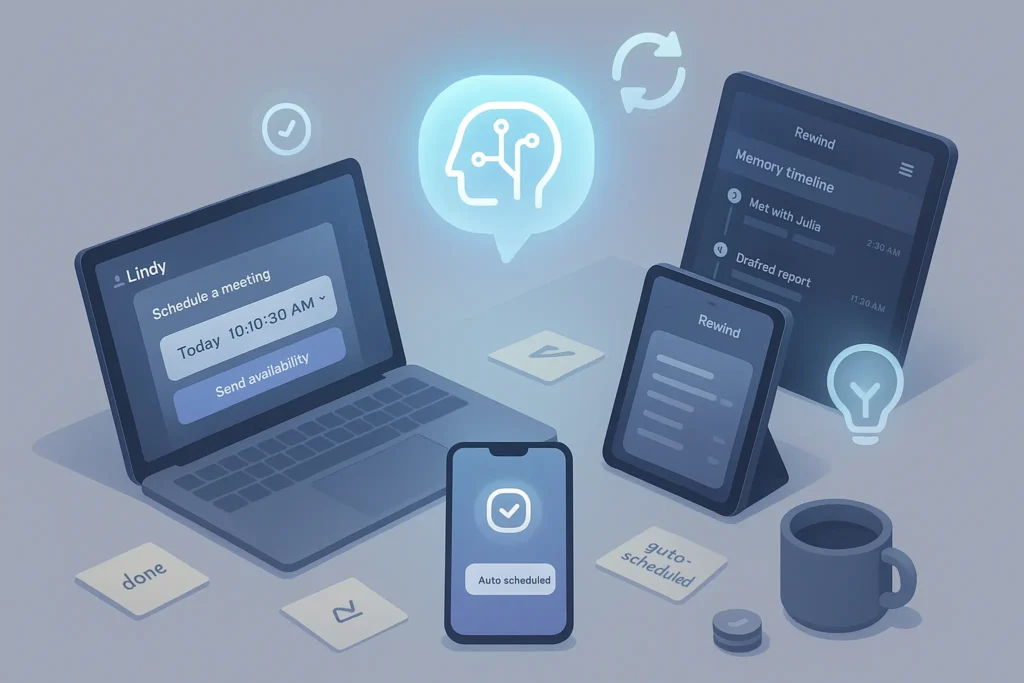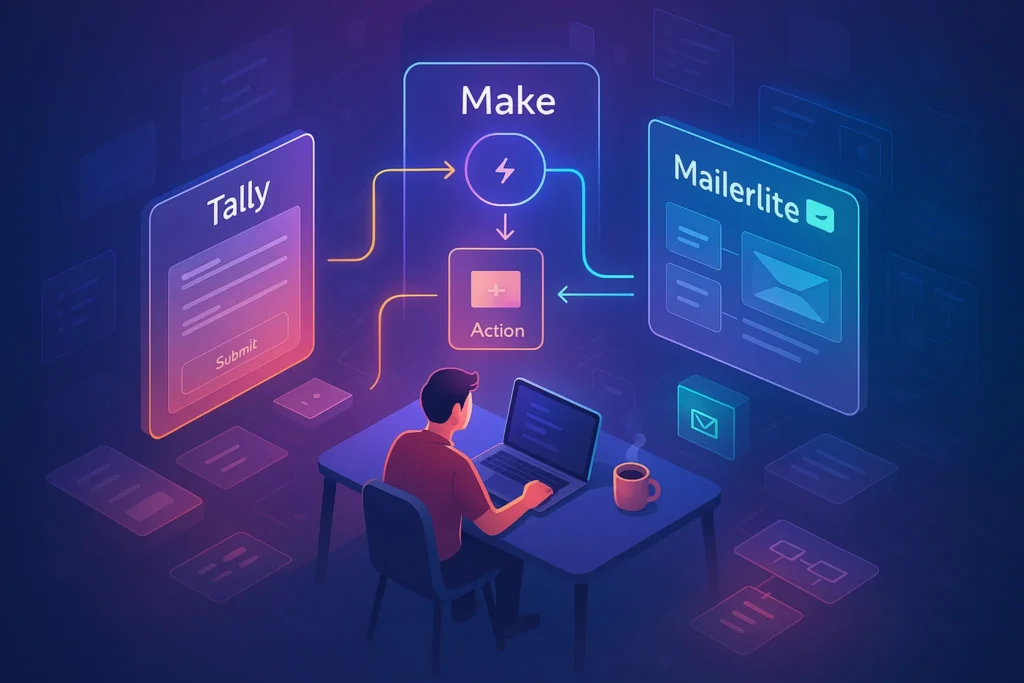-This post may contain affiliate links. If you click on one and make a purchase, I may earn a small commission at no extra cost to you.-
🧠 Introduction: Can AI Really Take Tasks Off Your Plate?
Between emails, scheduling, status updates, reminders, and “just one more thing,” the average solopreneur or creator can feel like they’re working in their business more than on it. But what if you had a personal assistant that never slept, never forgot, and learned your preferences with every interaction?
That’s the promise of today’s AI-powered assistants. Unlike basic task managers or static workflows, modern AI agents adapt in real-time, handle communication, summarize meetings, and even suggest next steps—all with minimal input.
Whether you’re a content creator, remote project manager, or overwhelmed freelancer, this post will show you how to automate your day using AI with tools that act like a second brain.
🎯 Use-Case Layering: Who Needs This?
Let’s break down how different professionals benefit from AI task assistants:
-
✅ Content Creators
Quickly summarize ideas, organize your publishing calendar, and even draft captions or replies to audience comments using Personal.ai or Claude. -
✅ Project Managers
Let Lindy or Bardeen keep track of meetings, auto-schedule follow-ups, and ensure nothing slips through the cracks on your Kanban board. -
✅ Solopreneurs
Offload daily admin: Rewind tracks decisions, while ChatGPT handles customer responses, auto-generates documents, or summarizes leads. -
✅ Overwhelmed Humans
If your to-do list runs your life, these tools help create order from chaos—by sorting, suggesting, and sometimes even doing the work.
When talking about automating your calendar and prioritizing tasks, tools like Motion and GPT agents shine. For an in-depth walkthrough, check out How AI Can Automate Your To-Do List and Calendar.
🔧 Rewind – Your AI-Powered Memory
Rewind acts as a searchable memory for your digital life. Once installed, it automatically records everything you see, hear, or say on your device—this includes meetings, emails, websites, and even conversations. Its core value lies in making every moment retrievable. No more digging through files or trying to remember where you saw that one idea or link.
Instead of manually taking notes during a Zoom call or trying to remember the name of a website you visited three days ago, Rewind allows you to simply type what you remember (e.g., “UX feedback on homepage”) and instantly brings up the relevant moment. What sets it apart is its local-first architecture, which means all recordings are stored privately on your machine—not on the cloud.
This makes it ideal for users who need high recall (like product managers, consultants, or content creators) without compromising their data privacy.
Rewind is an “always-on” tool that records everything you’ve seen or typed on your device—securely and privately. You can search across emails, meetings, code, messages, and files instantly.
Why It’s Powerful:
-
Automatically generates to-do suggestions from what you did (not just what you planned).
-
Summarizes past meetings, documents, or websites in seconds.
-
Acts as a real-time personal knowledge base.
Use Case: A busy startup founder who can’t remember what was agreed in last week’s pitch call can just search their Rewind and get a summary + next actions.
🔧 Lindy – Your Executive Assistant, Reimagined
Lindy is not just an assistant that gives suggestions—it actually acts on your behalf. It connects with your Gmail, calendar, documents, and even your to-do apps. Once it understands your context, it can do things like respond to emails in your tone, book meetings intelligently based on everyone’s availability, remind you of follow-ups, and summarize documents.
The real value of Lindy comes from its ability to interpret natural language instructions like “Reschedule my 3 PM with Alex to next week and send a polite explanation” — and it just gets it done. It also learns your style over time, meaning the replies it sends feel increasingly like they’re coming from you.
It’s best suited for busy professionals—marketers, project managers, or founders—who deal with overflowing inboxes and scheduling chaos.
Lindy isn’t just a chatbot. It’s a task-oriented AI that can act on your behalf: scheduling meetings, replying to emails, and even managing your calendar based on context.
Why It’s Unique:
-
Can negotiate time slots directly with others.
-
Accesses your real calendar and inbox.
-
Understands intent: “reschedule my call with Sara” actually does it.
Real Example:
“I asked Lindy to find time with 3 teammates next week. It coordinated via email, found a shared slot, and booked the Zoom—without me replying once.”
🔧 Personal.ai – Build a Digital Version of You
Personal.ai is designed to replicate your voice, memory, and thought patterns so it can communicate on your behalf. Think of it as a personalized chatbot trained on your past conversations, writings, and ideas.
It doesn’t just autocomplete text—it generates intelligent, full responses that match your tone, vocabulary, and values. You can feed it your emails, social media interactions, or even Slack conversations, and over time, it starts sounding indistinguishably like you.
This is especially powerful for creators, coaches, and solopreneurs who manage online communities, need to reply to lots of messages, or want to maintain a consistent personal brand even when they’re not online.
This tool creates a memory model of your writing, decisions, and preferences. It learns over time and can compose replies in your tone on platforms like Twitter, Gmail, or Slack.
Key Features:
-
Reply drafting for messages
-
Memory-based responses (based on past writing)
-
Contextual replies across platforms
Use Case: For creators or marketers managing dozens of replies per day, Personal.ai can save hours while keeping your brand voice consistent.
🔧 GPT-4, Bard, Claude – Your On-Demand Brain
These advanced large language models act as hyper-intelligent co-pilots. You can ask them to write content, debug code, analyze contracts, summarize meetings, generate business plans, or even simulate interviews or sales calls.
-
GPT-4 is widely considered the best all-rounder—especially for writing, structured thinking, and code generation.
-
Claude (from Anthropic) handles large documents extremely well and is great at summarization and following nuanced instructions.
-
Bard, integrated with Google, is fast and useful for tasks involving search or spreadsheet manipulation.
These tools shine when you don’t want a full-time assistant but still want intelligent help at your fingertips. They’re perfect for researchers, writers, analysts, and anyone who wants to speed up deep work.
You already know them—but used strategically, they can handle 80% of your daily micro-decisions. Examples include:
-
Drafting outlines or responses
-
Summarizing meeting notes
-
Comparing options (“What’s the cheapest AI newsletter platform?”)
-
Prioritizing to-dos based on urgency
💡 Bonus Tip: Claude excels at long-form structured writing. GPT-4 is stronger at reasoning. Bard shines when connected to Google Workspace.
🔧 Bardeen + ChatGPT – Chrome-Level Automation
Bardeen is a browser automation tool that becomes exponentially more powerful when paired with ChatGPT. On its own, Bardeen can automate repetitive web tasks—copying info between tabs, clicking buttons, scraping emails or LinkedIn profiles, filling out forms, or triggering Slack messages.
But when you add ChatGPT to the mix, you unlock context-aware automation. For instance, Bardeen can extract job titles from LinkedIn profiles, send them to ChatGPT to generate personalized outreach messages, and then auto-fill those into Gmail drafts—all without human input.
It’s like giving your browser a brain and hands at the same time.
Perfect for recruiters, sales pros, and solo operators who juggle multiple web-based workflows every day.
When Bardeen connects with GPT, it becomes a powerful automation layer for your browser. Think: scraping data, generating emails, or syncing info between tools like Notion, Slack, and Google Calendar.
Use Case:
You’re researching leads. Bardeen scrapes names + emails from LinkedIn and prompts ChatGPT to draft intros for each. With one click, they’re added to your CRM.
🧪 Micro-Comparison: Rewind vs Personal.ai | Lindy vs Motion
🆚 Rewind vs Personal.ai
| Feature | Rewind | Personal.ai |
|---|---|---|
| Focus | Memory capture + search | Memory modeling + messaging |
| Privacy | Local + encrypted | Encrypted, AI training on your data |
| Interaction | Passive logging + querying | Active reply generation |
| Best For | Solopreneurs, founders | Creators, marketers |
📌 Verdict: If you want an AI that remembers, use Rewind. If you want one that speaks for you, Personal.ai is your match.
🆚 Lindy vs Motion
| Feature | Lindy | Motion |
|---|---|---|
| Assistant Type | Executive AI assistant | Smart calendar / auto-scheduler |
| Autonomy | Acts on your behalf | Suggests based on context |
| Interface | Conversational AI | Visual daily planner |
| Best For | Inbox & meetings | Task prioritization & planning |
📌 Verdict: Use Lindy if you want AI to do things (email, schedule). Use Motion if you just want to optimize your schedule without micromanaging.
⏳ How Much Time Do AI Assistants Really Save?
Let’s talk about real numbers. AI tools can sound flashy, but what’s the actual impact on your week?
| Task | Manual Time | With AI |
|---|---|---|
| Email triage (daily) | ~45 mins | ↓ to 10–15 mins with Lindy |
| Scheduling (weekly) | ~2 hrs | ↓ to <20 mins with Motion or Lindy |
| Social replies (Twitter/DMs) | ~1 hr/day | ↓ to 10–20 mins with Personal.ai |
| Research + Note Sorting | ~90 mins/session | ↓ to 10–15 mins with Rewind or ChatGPT |
That’s a potential 7–10 hours/week saved—without hiring a human assistant.
Now imagine combining multiple tools into a seamless system…
🧩 How to Combine AI Tools into One Workflow
Here’s a high-leverage way to stack them:
-
🎧 Start with Rewind – It tracks everything you do, so you never lose context or ideas.
-
📬 Lindy picks up from there – handling your inbox and scheduling while pulling from Rewind when needed.
-
🤖 Use GPT-4 or Claude – for fast writing, summaries, and structured decisions.
-
🧠 Layer in Personal.ai – to handle your social presence, messages, and team communication in your tone.
-
🔁 Automate glue tasks with Bardeen or Zapier – moving data between platforms silently.
This ecosystem allows you to focus on the “why”, not the “how” of your tasks.
✳️ Related insight: Workflow Automation Tools for Solopreneurs covers how to build this kind of multi-tool stack for solo operators.
⚠️ What Could Go Wrong? (Risk & Trust Layer)
Even the smartest AI can occasionally go sideways. Here’s where to be cautious:
-
❌ Scheduling Errors – Lindy might double-book if not synced across calendars.
-
❌ Tone Mismatch – Personal.ai might draft a reply that feels off if not trained enough on your past writing.
-
❌ Security Concerns – If Rewind or Lindy has access to your email, use 2FA + secure environments.
👨💻 Nerd Tip: Always review AI-generated messages at first. You’re training the tool and protecting your brand.
Over time, just like a human VA, your AI assistant gets smarter and more reliable.
💡 Bonus: Real-Life AI Agent Use Cases
✅ Use Case #1: Auto-Schedule My Week
A solopreneur uses Lindy to handle all incoming meeting requests, propose open slots, and sync it with Zoom & Google Calendar—saving ~3 hours per week.
✅ Use Case #2: Memory Recall Without Notes
A remote PM uses Rewind to review last month’s meetings across Slack, Notion, and Google Docs. With one search, they generate a clean timeline of decisions.
✅ Use Case #3: Ghostwriting Social Replies
A busy YouTuber uses Personal.ai to respond to DMs and Twitter threads in their brand voice—even while offline.
AI Assistants for Focus & Mental Clarity
While most people adopt AI tools to save time, one of their most underrated benefits is the mental clarity they provide. By reducing micro-decisions, AI assistants can declutter your brain and create space for creative or deep work.
Tools like Serene and Flow.club are pioneers in this space. They combine AI-driven scheduling with mindful productivity. Serene blocks distractions and creates timed focus blocks, while Flow.club provides accountability rooms where users “work silently together,” guided by AI prompts.
Even ChatGPT has plugins like “Focus Assistant” that scan your calendar, suggest optimal deep work windows, and help you reprioritize tasks if you’re overloaded.
🧩 Use Case: Focus in the Midst of Chaos
A content creator juggling freelance clients and social media uses Flow.club to join daily deep work rooms. While she works, ChatGPT filters and summarizes incoming emails every hour. As a result, she reports “more progress in 3 hours than I used to get in a full day.”
By outsourcing task-switching decisions to AI, users can enter longer flow states—and that’s where the real magic happens.
🔮 Future Outlook: Where AI Assistants Are Headed (2026–2030)
We’re just scratching the surface of what AI assistants can do. In the next 3–5 years, expect a massive shift toward assistants that are:
-
Multimodal – They’ll see, hear, read, and speak across all your platforms
-
Proactive – Instead of asking “How can I help?”, they’ll act before being prompted
-
Collaborative – Multiple AI agents will coordinate together to handle workflows end-to-end
Imagine a scenario where your Lindy assistant schedules your day, your GPT agent writes your newsletter draft, and your Rewind assistant surfaces key moments from last week’s meeting—all without you lifting a finger.
As devices evolve, so will the interfaces:
Smart earbuds may whisper reminders. AR glasses may display next steps. Your assistant might not even feel “digital”—just… helpful.
The future of productivity isn’t more hustle. It’s invisible delegation.
⚠️ Risks & Ethical Considerations of AI Assistants
AI assistants are powerful—but they come with a unique set of risks that every user should be aware of.
🔐 1. Data Privacy & Ownership
Tools like Rewind record everything on your screen. While they promise local-first storage, you’re still trusting software with incredibly sensitive context. Always verify whether your data is encrypted, locally stored, and not being used for training models.
🧠 2. Cognitive Offloading
When your assistant replies to emails, books meetings, and makes decisions, you risk losing touch with your own decision-making muscles. AI should be augmentation—not replacement—for your judgment.
⚖️ 3. Bias & Alignment
If your AI is trained on your past content, it may unintentionally reinforce outdated views, biases, or patterns you’ve grown out of. Periodic review and feedback loops are essential to keep your assistant aligned with who you are now.
✅ Takeaway:
AI assistants aren’t magic—they’re tools. Used wisely, they boost clarity. Used blindly, they can lead to dependence, missteps, or even exposure.
💬 Real User Testimonial
“After two weeks with Lindy and Personal.ai, I genuinely felt like my head had more room to breathe. Tasks got done. Emails got answered. But more than that, I could think again.
My AI wasn’t just saving me time—it was saving me mental bandwidth. I didn’t realize how much tiny decisions were draining me.”
– Tasha A., Solopreneur & Wellness Coach
🧠 Nerd Verdict: “The AI Isn’t Replacing Me—It’s Scaling Me”
I’ve personally tested many of these tools in my daily workflow. The biggest “wow” moment?
Using Rewind + Personal.ai to offload both information recall and brand communication—without hiring a VA.
These AI agents aren’t just helpers. They’re digital replicas that extend your reach. When used right, they free up headspace for what actually matters—creating, strategizing, or resting.
-
Curious about more future-facing tools? We break down essential AI apps for daily productivity in AI Tools Everyone Should Know in 2025.
❓ FAQ: Nerds Ask, We Answer
Q: Can AI assistants manage sensitive data?
A: Yes, but be cautious. Tools like Rewind store data locally and encrypt it. Lindy and Personal.ai offer strict permission settings.
Q: What if the AI makes mistakes?
A: AI tools improve with context. Regular usage + feedback loops make them more reliable over time. Always review output initially.
Q: How much do these tools cost?
A: Rewind offers a freemium tier. Lindy and Personal.ai have plans starting around $15–30/month. GPT access may require OpenAI Pro or API credits.
Q: Do these tools work together?
A: Yes! You can use Bardeen or Zapier to integrate them. For example, create a Rewind summary → send to Notion via automation → trigger Personal.ai to draft a recap.
💬 Would You Bite?
So, if you could hand off your calendar, emails, and task follow-ups to an AI assistant…
Would you trust it? Which tool from this list would you actually try this week?
Drop your thoughts—especially if you’ve tested any of these in real life. 👇



